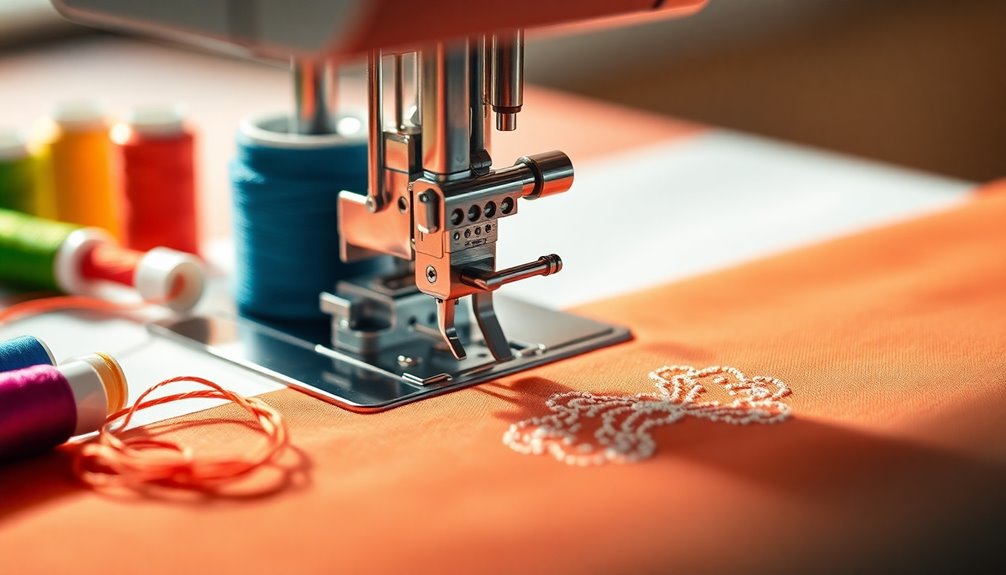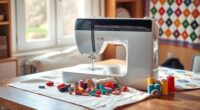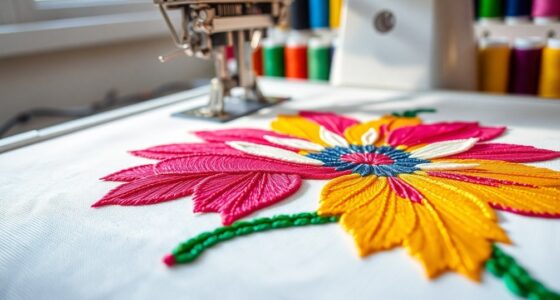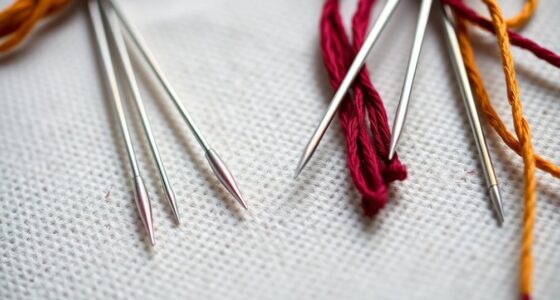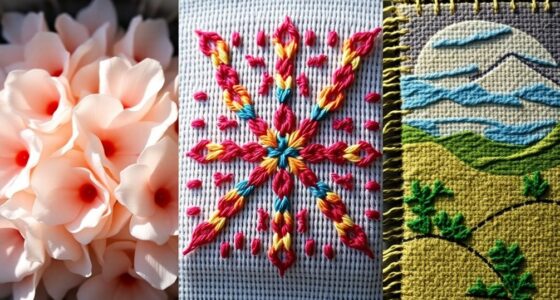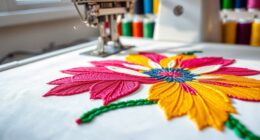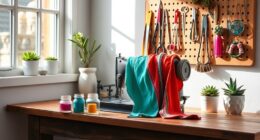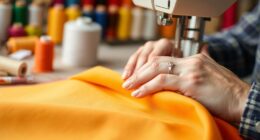Yes, you can use embroidery thread in your sewing machine! Just keep in mind that it's softer and less strong than regular sewing thread, so you'll need to adjust your machine for ideal tension. Use an embroidery or topstitching needle to prevent breakage, and start with a mid-range tension setting. Slower sewing speeds can improve stitch quality. If you want tips on challenges and techniques to make the most of your projects, keep exploring!
Key Takeaways
- Yes, you can use embroidery thread in your sewing machine for decorative stitching, quilting, and topstitching, but avoid using it for seams.
- Adjust the tension settings on your machine to accommodate the softer nature of embroidery thread for optimal stitch quality.
- It's best to use embroidery or topstitching needles with a larger eye to prevent thread breakage when using embroidery thread.
- Conduct tests on scrap fabric to fine-tune tension and ensure stitch quality before starting your main project.
- Monitor for thread breakage or uneven stitches, which may indicate the need for tension adjustments or needle changes.
Understanding Embroidery Thread

Embroidery thread is an essential tool for anyone looking to add decorative flair to their sewing projects.
Unlike regular sewing thread, which is usually made from cotton or blends, embroidery thread is crafted from rayon or polyester. This gives it a beautiful sheen that enhances visibility and reduces lint.
Designed for higher stitching speeds, it's softer and more lustrous, making it perfect for decorative applications. The standard weight for embroidery thread is 40wt, suitable for most machine embroidery designs.
However, keep in mind that it's not ideal for seams due to its lower strength compared to regular sewing thread. Understanding these differences helps you make the right choice for your projects.
Benefits of Using Embroidery Thread in Sewing

Using embroidery thread opens up a world of vibrant color options that can truly elevate your sewing projects.
You'll notice how it enhances decorative details, adding depth and dimension to your designs.
With such creative possibilities at your fingertips, your finished pieces will stand out like never before.
Vibrant Color Options
With countless vibrant color options available, embroidery thread can transform your sewing projects into eye-catching masterpieces. The rich palette of embroidery thread colors surpasses traditional sewing threads, allowing you to create stunning designs. Its sheen enhances color vibrancy, making your creations pop and stand out.
| Color Type | Finish Type | Unique Feature |
|---|---|---|
| Solid Colors | Matte | Consistent hue |
| Metallic | Shiny | Reflects light |
| Variegated | Gradient | Multi-color effect |
Using embroidery thread opens up endless creative possibilities, whether you choose specialty finishes or bold hues. Elevate your projects into works of art with the striking visual elements that embroidery thread provides.
Enhanced Decorative Detail
When you incorporate embroidery thread into your sewing projects, you instantly elevate the decorative detail and visual appeal. This type of thread is designed to add vibrant colors and intricate details, transforming your creations into eye-catching pieces.
Its unique sheen enhances the overall aesthetic, making it perfect for decorative stitches, quilting, and embellishments. The thickness of embroidery thread allows you to create textures and designs that can turn basic projects into stunning works of art.
Additionally, it opens up new creative possibilities, enabling you to craft personalized designs that truly stand out. Whether you're working on free-motion embroidery or satin stitches, the softness and luster of embroidery thread will showcase your skills beautifully.
Challenges of Using Embroidery Thread

Although embroidery thread can add a beautiful finish to your projects, it also presents several challenges that can frustrate even experienced sewists. The thickness of embroidery thread can lead to thread breakage if you don't manage it properly. Adjusting the thread tension is essential; incorrect settings can yield poor stitch quality. You might also face compatibility issues on delicate fabrics, where the thicker thread may cause puckering. Additionally, the softer nature of embroidery thread may complicate achieving the desired stitch density, especially in high-density designs. Experimentation with speed, tension, and needle type is often necessary, which can be time-consuming for beginners.
| Challenge | Solution |
|---|---|
| Thread breakage | Manage tension carefully |
| Poor stitch quality | Adjust thread tension |
| Puckering on fabrics | Choose appropriate fabrics |
| Stitch density issues | Experiment with settings |
Compatibility of Embroidery Thread With Sewing Machines

Using embroidery thread in your sewing machine can enhance your projects, but it's important to understand its compatibility.
While you can use embroidery thread for decorative stitches, quilting, and topstitching, it's not the best choice for seams due to its lower strength.
Here are some tips to guarantee a smooth experience:
- Adjust the tension settings on your sewing machine for ideal stitch quality.
- Use an embroidery needle or topstitching needle, as these accommodate the thicker thread.
- Be cautious with dense embroidery designs to avoid thread breaks.
- Always test on scrap fabric before starting your project to check compatibility.
Types of Embroidery Thread

Embroidery threads come in various types, each offering unique qualities that can enhance your projects.
Polyester embroidery thread is strong and durable, making it ideal for machine embroidery, with a vast range of colors that resist fading.
Rayon embroidery thread, on the other hand, boasts a luxurious sheen and vibrant hues but is less durable and may fade over time.
If you prefer a traditional look, cotton embroidery thread made from natural fibers can provide that, though it's not as strong or colorfast as synthetic options.
Specialty embroidery threads like metallic, glow-in-the-dark, and variegated varieties add unique visual effects.
Finally, embroidery bobbin thread is thinner than standard threads, reducing bulk in high-density designs and allowing for smoother stitching.
Tips for Using Embroidery Thread in a Sewing Machine

Choosing the right type of embroidery thread sets the stage for successful projects, but knowing how to use it in your sewing machine is just as important. Follow these tips to guarantee a smooth experience:
- Select the Right Needle: Use a needle designed for embroidery or topstitching, as they've larger eyes to handle thicker embroidery thread.
- Adjust Tension: Change your machine's tension settings, since embroidery thread often requires different settings than regular sewing thread.
- Slow Down: Reduce your sewing speed to prevent thread breakage and fabric puckering.
- Test on Scrap Fabric: Always conduct a waste cloth test to identify any tension or thread issues before starting your main project.
Needle Selection for Embroidery Thread

Choosing the right needle is essential when working with embroidery thread.
You'll want to pick needles specifically designed for embroidery or topstitching, as they accommodate thicker threads better.
Additionally, consider the needle size; a larger eye can help prevent breakage and improve your stitching experience.
Needle Type Importance
When working with embroidery thread, selecting the right needle type is essential for achieving the best results.
Using the proper needle guarantees that you have fewer issues with breakage and fraying. Here are some key considerations:
- Choose needles labeled as "embroidery" or "topstitching" for thicker threads.
- Opt for needles with a larger eye to facilitate threading and reduce thread damage.
- Regularly replace your needles to maintain stitch quality, as embroidery thread can be demanding.
- For standard embroidery thread, a size 75/11 needle is often recommended, while specialty threads may need specific types.
Needle Size Considerations
Selecting the right needle size is essential for successful embroidery projects. Using needles labeled as "embroidery" or "topstitching" helps accommodate the thicker embroidery thread, preventing breakage. Opt for needles with a larger eye, like Schmetz size 75/11, to make threading easier and reduce strain on the thread.
| Needle Type | Best For |
|---|---|
| Sharp Point | Woven fabrics |
| Ballpoint Needle | Knits and stretch fabrics |
| Regular Needles | General sewing (not ideal) |
Regularly replace your needles to maintain stitch quality and avoid tension issues. Choosing the correct needle size not only enhances your stitching but also helps you achieve those intricate designs you love without thread mishaps.
Adjusting Tension for Optimal Stitch Quality

To achieve ideal stitch quality with embroidery thread, adjusting the tension is essential. Start with a mid-range tension setting for initial testing, but be prepared to make changes. Here's how to get it right:
- Test Stitching: Always test on scraps of your fabric before starting your project.
- Monitor Thread Type: Different weights of embroidery thread may require distinct tension settings; thicker threads often need looser tension, while thinner threads benefit from tighter settings.
- Check for Breakage: If the thread breaks or stitches are uneven, you may need to adjust your tension.
- Fine-Tune Regularly: Regularly check and adjust the tension during different projects, especially when switching fabrics or embroidery threads to maintain consistency.
Recommended Sewing Techniques With Embroidery Thread

While you might be keen to plunge into your embroidery project, employing the right sewing techniques with embroidery thread can greatly affect your results.
Start by using an embroidery needle, like a Schmetz size 75/11, to accommodate the thicker thread and prevent breakage. Adjust your sewing machine's tension settings based on the bobbin thread you're using, beginning with a mid-range tension for balanced stitches.
It's wise to sew at a slower speed to minimize thread disconnections and fabric puckering. Verify proper threading through your machine's thread path to avoid issues.
Finally, test on scrap fabric before diving into your main project; this helps identify any potential problems with tension and speed adjustments.
Testing and Troubleshooting Embroidery Thread Issues

When you start sewing with embroidery thread, testing and troubleshooting are essential to achieving the best results.
Here are some steps to help you address common issues:
- Conduct a waste cloth test on scrap fabric to identify potential thread behavior issues.
- Monitor thread tension closely; improper tension can lead to poor stitch quality or thread breakage.
- If you experience thread breakage, check the needle type and size—use a size 75/11 embroidery needle for best results.
- Regularly inspect the threading path for obstructions or tangles that could disrupt your sewing.
Frequently Asked Questions
Do You Use the Same Thread for Sewing and Embroidery?
When you're sewing and embroidering, you don't always use the same thread. Regular sewing thread is stronger and better for seams, while embroidery thread adds a decorative touch with its softer, lustrous finish.
If you're working on a project that requires both functionality and flair, it's best to choose the appropriate thread for each task. Adjust your machine settings accordingly to guarantee the best results, especially when switching between thread types.
Can You Use Embroidery Floss in a Machine?
You can technically use embroidery floss in a sewing machine, but it's not the best choice.
You'll need to separate a strand and hand-wind it onto a bobbin, which can be time-consuming.
Remember, embroidery floss isn't strong enough for seams; it's better for decorative purposes.
If you decide to try it, test on a scrap fabric first to see how it performs before committing to your main project.
Can You Turn a Sewing Machine Into an Embroidery Machine?
Imagine your sewing machine as a caterpillar, yearning to become a butterfly. You can transform it into an embroidery machine with the right tools.
By adding a specialized embroidery foot, a hoop, and digitizing software, you reveal its hidden potential. Some machines even come pre-equipped for this change.
While it may not reach the heights of a dedicated embroidery machine, with a bit of effort, you'll create beautiful designs that flutter with creativity.
Can You Use Embroidery Needles for Regular Sewing?
Yes, you can use embroidery needles for regular sewing.
These needles have a larger eye and sharper point, making them ideal for thicker threads. By using them, you'll enhance your stitch quality, especially when working with heavier materials.
Just keep in mind that while they're great for decorative purposes, regular needles might be better for basic sewing tasks.
Conclusion
To sum up, using embroidery thread in your sewing machine can elevate your projects to a whole new level of fabulousness! Imagine stitching with vibrant colors that practically dance off the fabric, turning your creations into masterpieces worthy of a gallery. Sure, there are a few challenges, but with the right techniques and adjustments, you’ll be unstoppable. So go ahead—embrace the magic of embroidery thread and watch as your sewing transforms into a dazzling spectacle that leaves everyone in awe! Additionally, experimenting with different stitches can further enhance the beauty of your work, allowing you to showcase intricate designs that truly shine. Not only does using embroidered thread for sewing purposes add depth and texture, but it also opens up endless possibilities for creativity. So gather your tools, let your imagination run wild, and create projects that reflect your unique style and flair!
